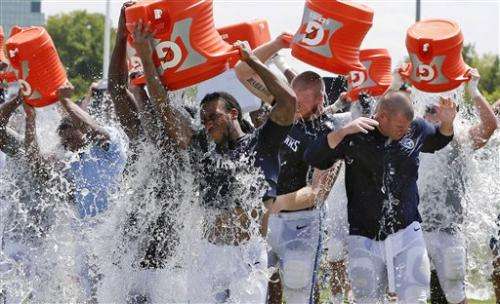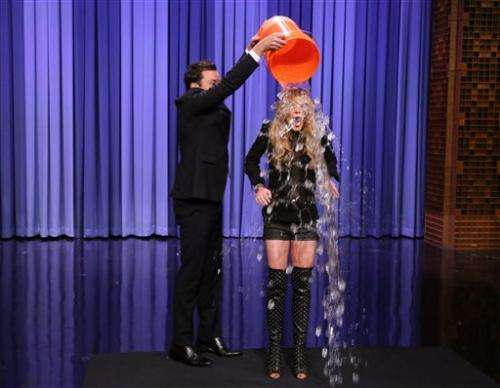Ice bucket challenge may change nonprofit world

The ice bucket challenge's phenomenal success is making other charitable organizations rethink how they connect with a younger generation of potential donors.
Since the ALS Association began tracking the campaign's progress on July 29, it has raised more than $53.3 million from 1.1 million new donors in what is one of the most viral philanthropic social media campaigns in history.
Thousands of people, including celebrities like Taylor Swift and Oprah Winfrey, have posted videos of themselves getting buckets of ice water dumped over their heads and challenging others to do the same—or donate money to The ALS Association, which raises money for Lou Gehrig's disease research and assistance.
The ice bucket challenge has shown it's OK to be silly for a good cause, says Brian Mittendorf, a professor at the Ohio State University Fisher College of Business, who teaches courses in nonprofit finance.
"Normally the model is to find people who are passionate about a cause and then ask for donations or to educate people and then seek out donations. (The ice bucket challenge is) something that's fun that people can do ... people are taking part in it and then taking the info and donating."
The viral nature of the effort surprised even The ALS Association.
"This level of unprecedented giving is (something) I don't think this country has seen before outside of a disaster or emergency," said ALS Association spokesperson Carrie Munk. "We had no idea it would get to this point."
Who should get credit for making this a viral sensation depends on whom you ask. Some say it began earlier this month when friends of a 29-year-old Boston man with ALS, a neurodegenerative disease that affects nerve cells in the brain and spinal cord, did a group challenge.
It's also demonstrated that the average Joe or Jane can make waves.
"One of the big take-aways is the power of individuals who are so tightly connected to a cause can really make a difference," Munk said. "I'm pretty sure that if any company or any nonprofit had all of the public relations dollars in the world to come up with a campaign, we never would've seen this kind of success."
Lucretia Gilbert, executive director of The Pink Agenda, which raises money for breast cancer research and awareness, believes it will encourage other nonprofits to get creative on social media.

"It's a very simple thing and that's kind of the beauty of it. Everyone can do this challenge," she said.
The effort comes at a time when private groups are searching for new ways to raise dollars in the wake of tighter federal government spending on basic medical research, including on diseases like ALS.
The National Institutes of Health is spending about $30 billion this year, money that is divided in a highly competitive process to scientists around the country, and the world, to pursue what are deemed the most promising leads to understand various diseases and to find new targets to fight them.
Congress cut government spending last year; in 2012, the NIH's budget was $30.8 billion. And even before those cuts, the agency's budget hadn't kept pace with inflation for about a decade. As a result, the NIH is funding about one in six grant applications—down from about one in three a decade ago, director Francis Collins said earlier this year.

For Lou Gehrig's disease, the NIH's estimated budget this year is $40 million, down from $44 million in 2012.
Employing technology for fundraising campaigns, of course, isn't a new idea: Perhaps one of the most enduring began in 1966 when the Muscular Dystrophy Association had its first annual Labor Day weekend telethon. Last year, it raised $59.6 million in contributions. Fundraisers have also embraced donating by text message in recent years.
But some fundraisers contend that one of their greatest challenges is asking the same people for money year after year—a challenge successful social media campaigns could solve.

Mindy Bailey, corporate and community development specialist for JDRF, a foundation that raises money to fight Type 1 diabetes, said volunteers want to come up with a similar idea to fuel donations.
"We have had a lot of people reach out to us and say, 'Hey, we're going to do the ice bucket challenge,'" Bailey said. "Recently we had a woman say, 'I'm thinking of doing a pie-in-your-face idea.' The wheels have been turning."
However, not everyone is a fan of the public approach of the ice bucket challenge.

#NoIceBucketChallenge is a hashtag on Twitter that's being used for a variety of reasons.
"I just think it seems hokey and far too gimmicky and a hot trend and part of the whole 'me' culture of 'Oh look at me. Pay attention to me,'" said Cameron Mitchell of New York. "The charity part seems like an afterthought."
Some even argue that it's wasteful to dump water, even for a cause, especially in places like California, where there's a drought.
The California Water Board offered a measured response.
"It doesn't violate any of our regulations. People should always use good judgment whenever they use water while we're in a drought. On the other hand, we understand that this is a charitable event," said George N. Kostyroko, director of the California State Water Resources Control Board's office of public affairs, in an email.

Annoyed, impressed or otherwise, the ice bucket challenge has people talking—and ALS's Munk asserts that even if they don't donate, the campaign has raised public awareness, a major focus of the organization that last year spent 32 percent of its annual budget on public and professional education and 27 percent on research.
Just a few years ago, she said, only about 50 percent of Americans knew what ALS is.
"We're really looking forward to see how the needle moves," she said.
More information: www.alsa.org/
© 2014 The Associated Press. All rights reserved.
















